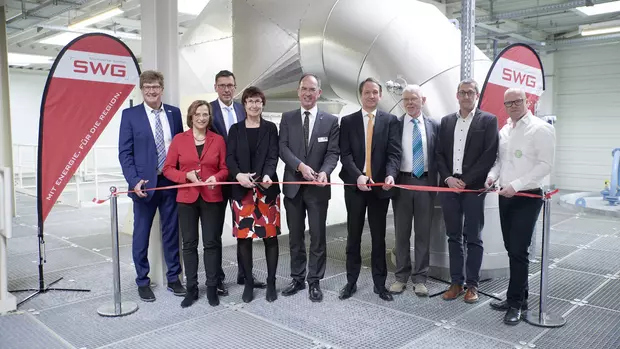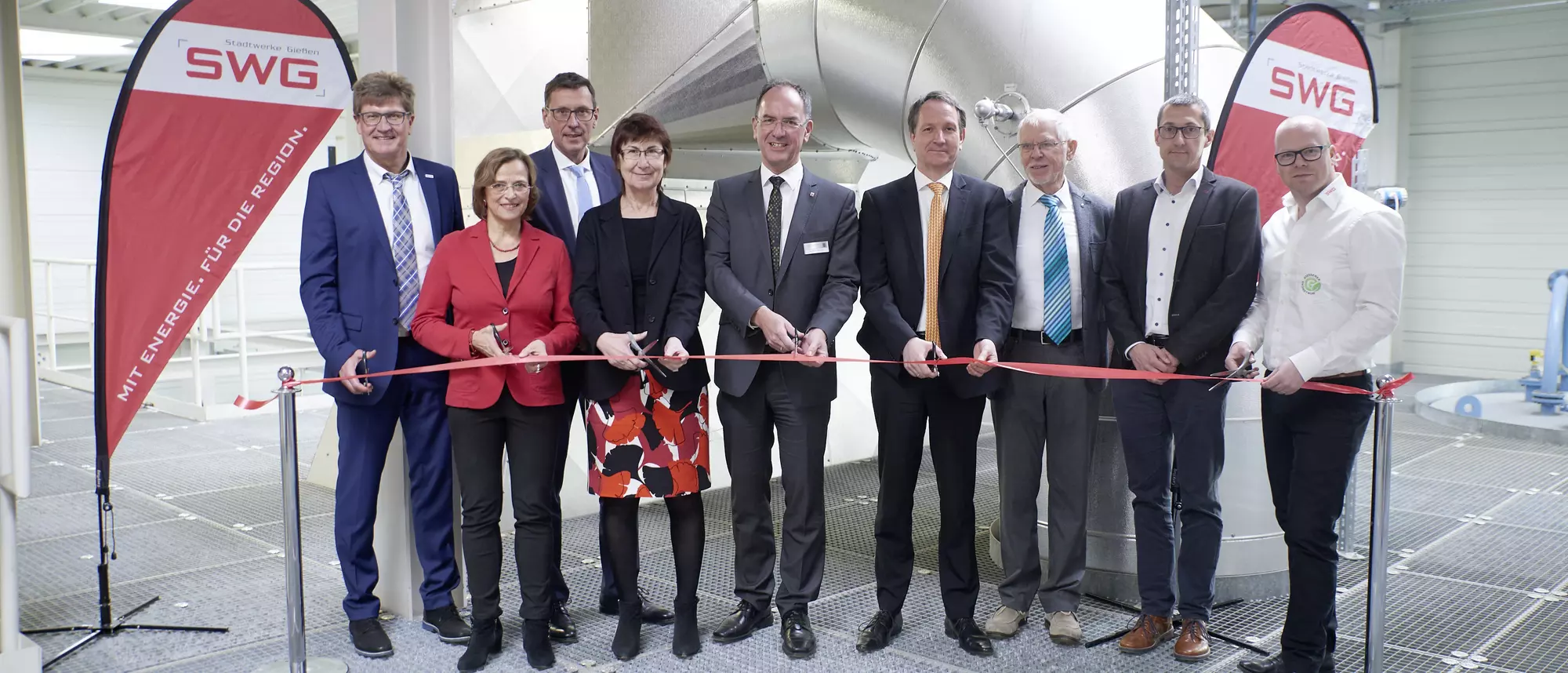
Regierungspräsident Dr. Christoph Ullrich, Prof. Olaf Berger, Vizepräsident der Technischen Hochschule Mittelhessen (THM), Prof. Dr. Fritz Richarts, emeritierter Professor der THM, Matthias Fink, Leiter Wärmeversorgung bei den SWG und Jens Hanig, verantwortlicher Projektleiter der SWG.
Giessen has gained a powerful andCO2-neutral combined heat and power plant: on 12 April, Stadtwerke Giessen inaugurated the second thermal waste treatment and energy utilisation plant. In future, it will cover up to nine per cent of the annual demand of Giessen's district heating customers and also supply electricity for around 10,000 households.
Turning waste into valuable heat is the order of the day in Giessen. Since 2010, the thermal residue treatment and energy utilisation plant (TREA) has played a key role in making Giessen one of Germany's pioneers when it comes to climate-friendly heat supply. Stadtwerke Gießen (SWG) is now expanding this status even further - thanks to TREA 2, which was officially inaugurated today. "We are breaking new ground with this significantly advanced plant," explains Matthias Funk, Technical Director of SWG, at the small celebration. In fact, there is not a single comparable combined heat and power plant in this country.
Heat and electricity
Waste-to-energy plants in themselves are nothing new. But the SWG engineers have approached the topic in a different way and developed nothing less than a new type of power plant. The problem: high steam temperatures, as required for electricity production, lead to corrosion in the boiler. The still unpurified exhaust gas from the combustion of the waste, with its acidic components, would dramatically increase the effect. In order to prevent this excessive corrosion, another method had to be found to bring the steam to the desired temperature. "In TREA 2, we achieve this with two natural gas-fuelled combined heat and power (CHP) units," adds Matthias Funk. The hot exhaust gases from these efficient units heat the steam to over 400 degrees Celsius and thus to a temperature that is suitable for electricity production.
Electricity and heat for thousands of households
The new combination of proven components offers many advantages. In addition to its high efficiency, the TREA 2 is particularly impressive due to its flexibility: "We can operate the plant in the range of 1.3 to 5.6 megawatts of electrical output. This allows us to react very well to the current electricity demand or to the respective market situation," summarises Matthias Funk. This makes the TREA 2 a winner not only from an ecological, but also from an economic point of view.
The profitability calculations carried out in advance are based on real experience - with the first TREA as well as with many other CHP modules - and speak for themselves: SWG's experts have so far assumed an annual running performance of around 7,400 hours. This means that the TREA 2 would cover the heating requirements of up to 3,300 single-family homes and the electricity requirements of around 10,000 average households.
Extracting every last kilowatt hour
As usual, the SWG specialists have looked at all the details and improved many things in the TREA 2 that turned out to be less than ideal in its predecessor. They took over some already positive aspects one-to-one. For example, the TREA 2 also utilises the heat contained in the exhaust gas, which provides an additional eight to nine percent yield. The TREA 2 also utilises the tried and tested flue gas cleaning system. However, instead of the comparatively expensive hydrogen carbonate - better known as baking powder - SWG uses low-cost hydrated lime. "This leads to exactly the same clean values in the flue gas, but reduces the operating costs enormously," says Matthias Funk happily.
In his welcoming address, District President Dr Christoph Ullrich referred to the good environmental balance of TREA 2: "A sustainable energy supply and a coherent waste disposal structure are essential today. TREA 2 conserves fossil resources and improves theCO2 balance of energy generation at SWG. At the same time, it relieves the burden on transport routes because it eliminates the need for long transport routes for waste."
The fact that TREA 2 is the third generation plant to be approved so close to a residential area can certainly be seen as a success by those responsible at SWG. "We played with open cards right from the start, involved all interest groups and answered all questions," says Matthias Funk, describing the process. In fact, there was not a single objection to the approval of the project from the local population. "This transparency was exemplary and very important for the fact that we now have another extremely efficient combined heat and power plant in Giessen," said a delighted Mayor Dietlind Grabe-Bolz on the occasion of the inauguration.
Impressive values
With TREA 2, SWG has taken an important step towards the energy transition in Central Hesse. As the figures show: The plant replaces 7,000,000 litres of heating oil per year, which equates to an annualCO2 saving of 25,000 tonnes. The primary energy factor of Giessen's district heating is also developing positively. With the start of regular operation, TREA 2 will reduce it from an already good 0.28 to 0.2. The factor indicates the ratio of the fossil fuels used to the heat produced. For Giessen, this means that in future SWG will only have to use 0.2 kilowatt hours of primary energy for every kilowatt hour of heat generated.
These impressive figures are no coincidence. As with TREA 1, SWG also relied on the advice of the Technical University of Central Hesse (THM) for TREA 2. "My colleague Professor Dr Fritz Richarts helped with the technical calculation models, for example," explained Professor Olaf Berger, Vice President of THM, in his speech. He also emphasised the many other successful collaborations between SWG and THM.
A look behind the scenes
SWG is now offering free tours of the two TREAs for interested members of the public. They are equally suitable for adult groups and school classes from year 7 upwards. As usual, SWG organises a bus transfer from Lahnstraße to the power plants and back. Registration and further details can be found at: www.swg-konzern.de/besichtigungen

